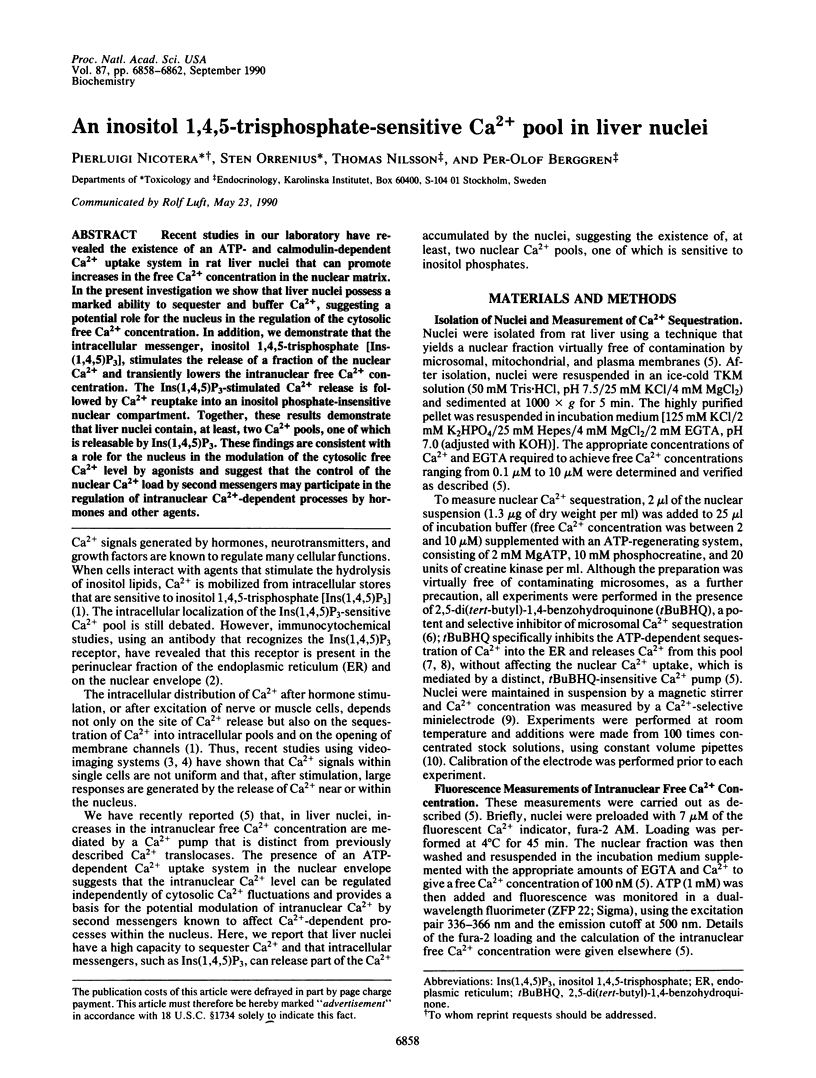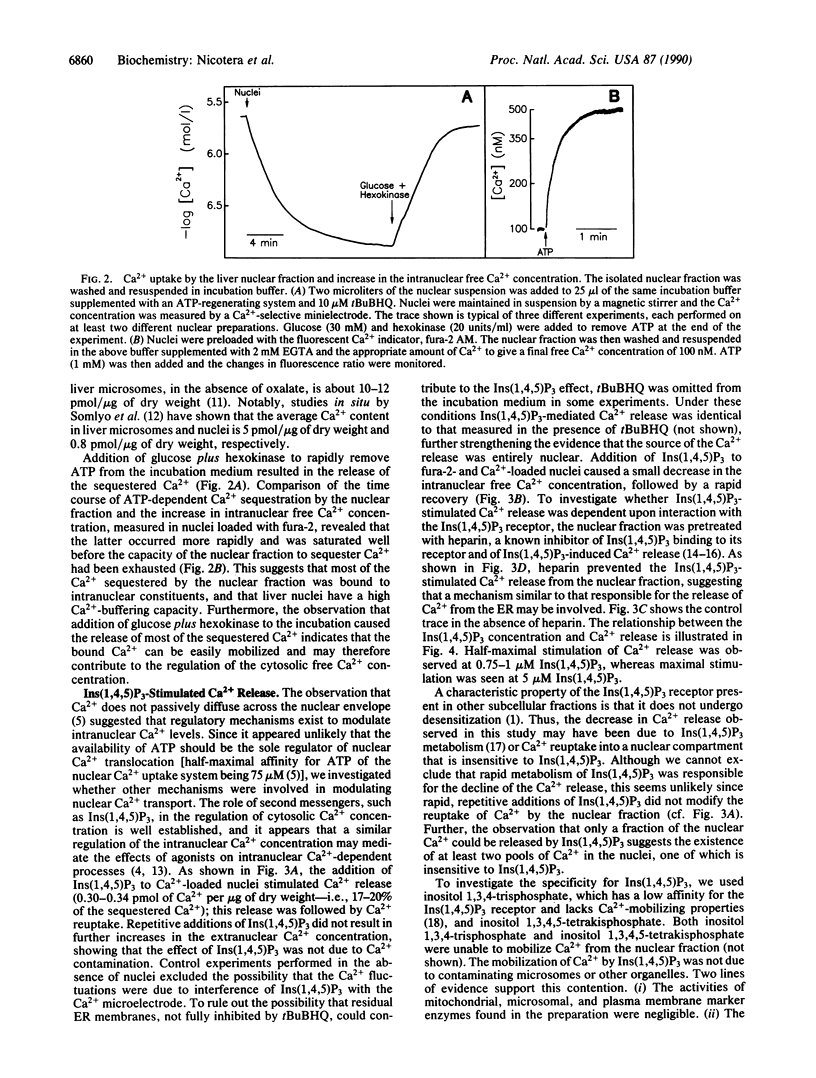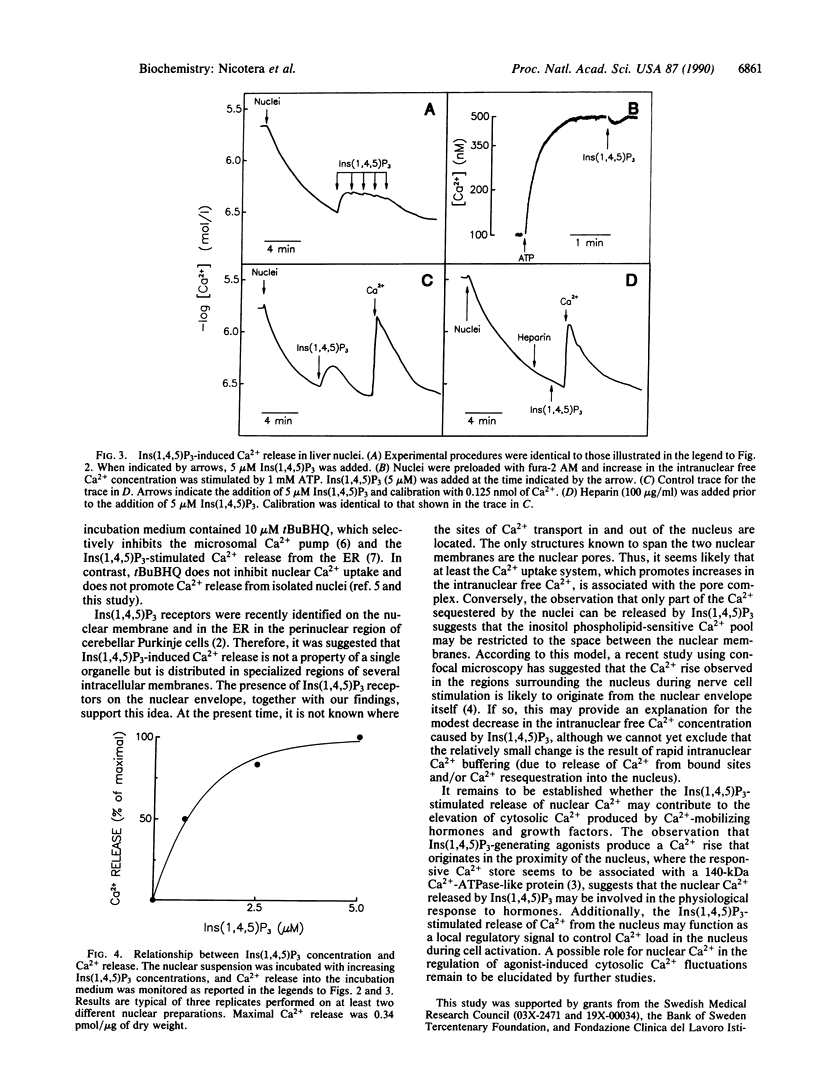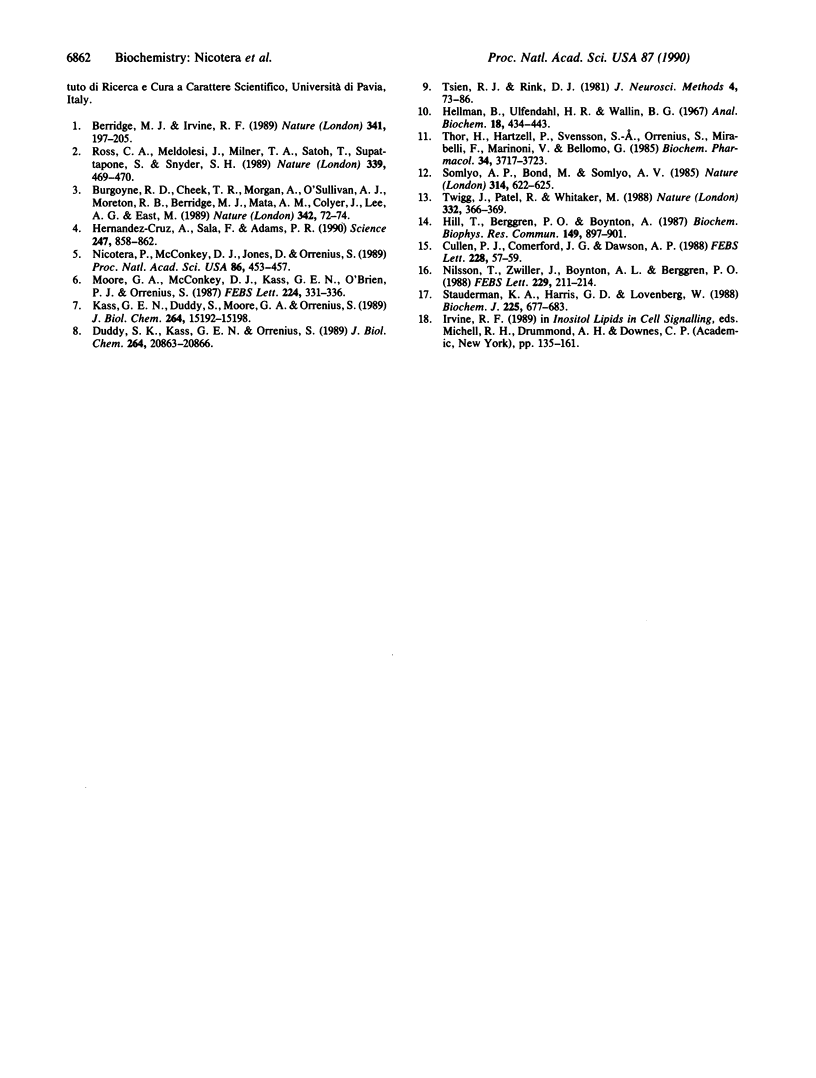Abstract
Recent studies in our laboratory have revealed the existence of an ATP- and calmodulin-dependent Ca2+ uptake system in rat liver nuclei that can promote increases in the free Ca2+ concentration in the nuclear matrix. In the present investigation we show that liver nuclei possess a marked ability to sequester and buffer Ca2+, suggesting a potential role for the nucleus in the regulation of the cytosolic free Ca2+ concentration. In addition, we demonstrate that the intracellular messenger, inositol 1,4,5-trisphosphate [Ins-(1,4,5)P3], stimulates the release of a fraction of the nuclear Ca2+ and transiently lowers the intranuclear free Ca2+ concentration. The Ins(1,4,5)P3-stimulated Ca2+ release is followed by Ca2+ reuptake into an inositol phosphate-insensitive nuclear compartment. Together, these results demonstrate that liver nuclei contain, at least, two Ca2+ pools, one of which is releasable by Ins(1,4,5)P3. These findings are consistent with a role for the nucleus in the modulation of the cytosolic free Ca2+ level by agonists and suggest that the control of the nuclear Ca2+ load by second messengers may participate in the regulation of intranuclear Ca2(+)-dependent processes by hormones and other agents.
Full text
PDF




Images in this article
Selected References
These references are in PubMed. This may not be the complete list of references from this article.
- Berridge M. J., Irvine R. F. Inositol phosphates and cell signalling. Nature. 1989 Sep 21;341(6239):197–205. doi: 10.1038/341197a0. [DOI] [PubMed] [Google Scholar]
- Burgoyne R. D., Cheek T. R., Morgan A., O'Sullivan A. J., Moreton R. B., Berridge M. J., Mata A. M., Colyer J., Lee A. G., East J. M. Distribution of two distinct Ca2+-ATPase-like proteins and their relationships to the agonist-sensitive calcium store in adrenal chromaffin cells. Nature. 1989 Nov 2;342(6245):72–74. doi: 10.1038/342072a0. [DOI] [PubMed] [Google Scholar]
- Cullen P. J., Comerford J. G., Dawson A. P. Heparin inhibits the inositol 1,4,5-trisphosphate-induced Ca2+ release from rat liver microsomes. FEBS Lett. 1988 Feb 8;228(1):57–59. doi: 10.1016/0014-5793(88)80584-2. [DOI] [PubMed] [Google Scholar]
- Duddy S. K., Kass G. E., Orrenius S. Ca2(+)-mobilizing hormones stimulate Ca2+ efflux from hepatocytes. J Biol Chem. 1989 Dec 15;264(35):20863–20866. [PubMed] [Google Scholar]
- Hernández-Cruz A., Sala F., Adams P. R. Subcellular calcium transients visualized by confocal microscopy in a voltage-clamped vertebrate neuron. Science. 1990 Feb 16;247(4944):858–862. doi: 10.1126/science.2154851. [DOI] [PubMed] [Google Scholar]
- Hill T. D., Berggren P. O., Boynton A. L. Heparin inhibits inositol trisphosphate-induced calcium release from permeabilized rat liver cells. Biochem Biophys Res Commun. 1987 Dec 31;149(3):897–901. doi: 10.1016/0006-291x(87)90492-x. [DOI] [PubMed] [Google Scholar]
- Kass G. E., Duddy S. K., Moore G. A., Orrenius S. 2,5-Di-(tert-butyl)-1,4-benzohydroquinone rapidly elevates cytosolic Ca2+ concentration by mobilizing the inositol 1,4,5-trisphosphate-sensitive Ca2+ pool. J Biol Chem. 1989 Sep 15;264(26):15192–15198. [PubMed] [Google Scholar]
- Moore G. A., McConkey D. J., Kass G. E., O'Brien P. J., Orrenius S. 2,5-Di(tert-butyl)-1,4-benzohydroquinone--a novel inhibitor of liver microsomal Ca2+ sequestration. FEBS Lett. 1987 Nov 30;224(2):331–336. doi: 10.1016/0014-5793(87)80479-9. [DOI] [PubMed] [Google Scholar]
- Nicotera P., McConkey D. J., Jones D. P., Orrenius S. ATP stimulates Ca2+ uptake and increases the free Ca2+ concentration in isolated rat liver nuclei. Proc Natl Acad Sci U S A. 1989 Jan;86(2):453–457. doi: 10.1073/pnas.86.2.453. [DOI] [PMC free article] [PubMed] [Google Scholar]
- Nilsson T., Zwiller J., Boynton A. L., Berggren P. O. Heparin inhibits IP3-induced Ca2+ release in permeabilized pancreatic beta-cells. FEBS Lett. 1988 Feb 29;229(1):211–214. doi: 10.1016/0014-5793(88)80829-9. [DOI] [PubMed] [Google Scholar]
- Ross C. A., Meldolesi J., Milner T. A., Satoh T., Supattapone S., Snyder S. H. Inositol 1,4,5-trisphosphate receptor localized to endoplasmic reticulum in cerebellar Purkinje neurons. Nature. 1989 Jun 8;339(6224):468–470. doi: 10.1038/339468a0. [DOI] [PubMed] [Google Scholar]
- Somlyo A. P., Bond M., Somlyo A. V. Calcium content of mitochondria and endoplasmic reticulum in liver frozen rapidly in vivo. Nature. 1985 Apr 18;314(6012):622–625. doi: 10.1038/314622a0. [DOI] [PubMed] [Google Scholar]
- Stauderman K. A., Harris G. D., Lovenberg W. Characterization of inositol 1,4,5-trisphosphate-stimulated calcium release from rat cerebellar microsomal fractions. Comparison with [3H]inositol 1,4,5-trisphosphate binding. Biochem J. 1988 Oct 15;255(2):677–683. [PMC free article] [PubMed] [Google Scholar]
- Thor H., Hartzell P., Svensson S. A., Orrenius S., Mirabelli F., Marinoni V., Bellomo G. On the role of thiol groups in the inhibition of liver microsomal Ca2+ sequestration by toxic agents. Biochem Pharmacol. 1985 Oct 15;34(20):3717–3723. doi: 10.1016/0006-2952(85)90236-9. [DOI] [PubMed] [Google Scholar]
- Tsien R. Y., Rink T. J. Ca2+-selective electrodes: a novel PVC-gelled neutral carrier mixture compared with other currently available sensors. J Neurosci Methods. 1981 Jun;4(1):73–86. doi: 10.1016/0165-0270(81)90020-0. [DOI] [PubMed] [Google Scholar]
- Twigg J., Patel R., Whitaker M. Translational control of InsP3-induced chromatin condensation during the early cell cycles of sea urchin embryos. Nature. 1988 Mar 24;332(6162):366–369. doi: 10.1038/332366a0. [DOI] [PubMed] [Google Scholar]




